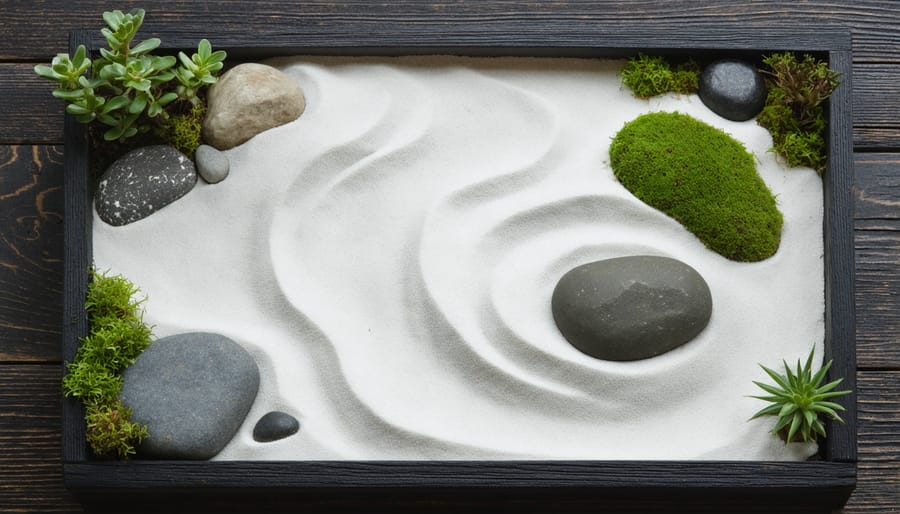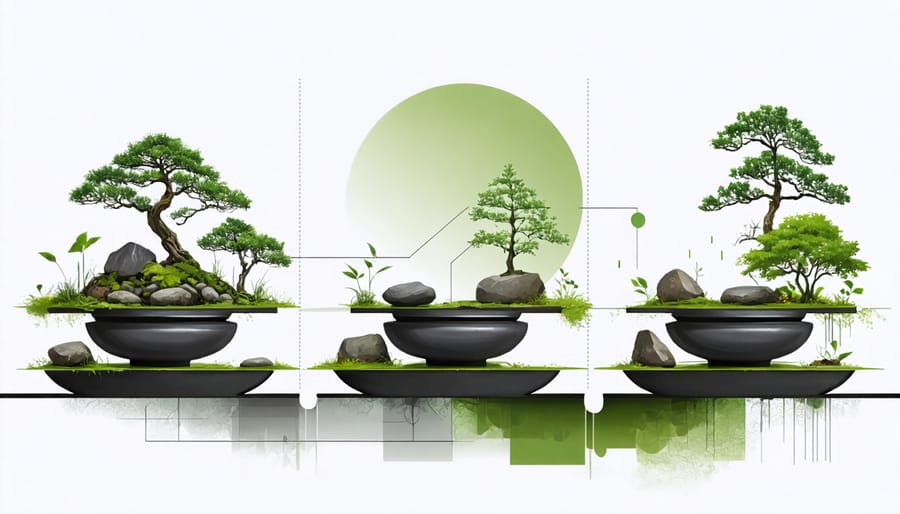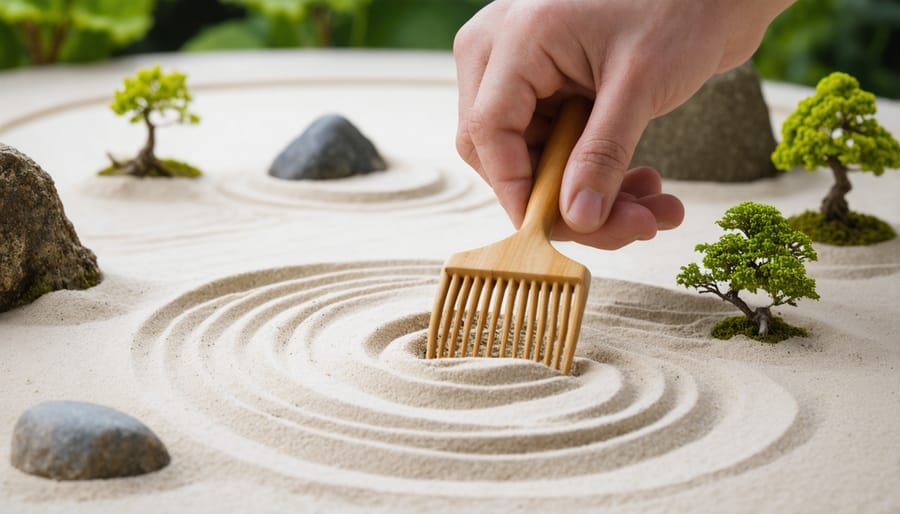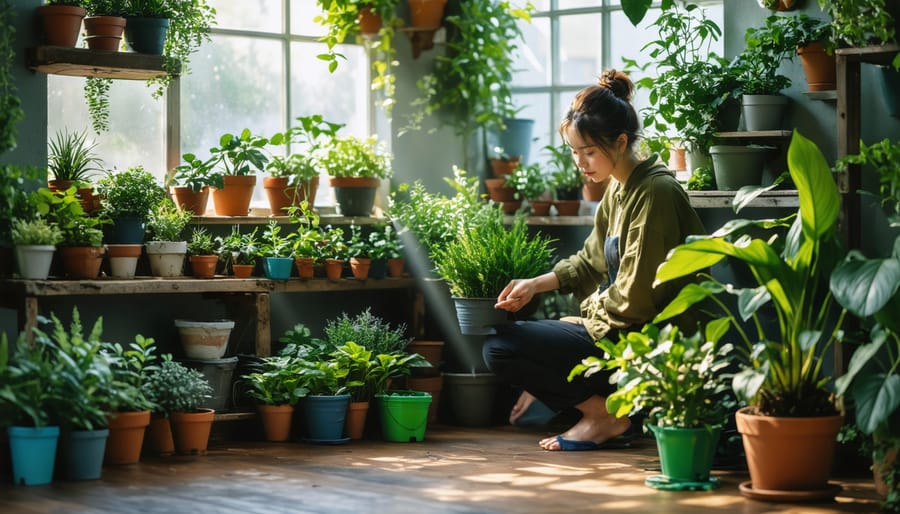Transform any indoor space into a serene zen sanctuary by creating a miniature rock garden in a shallow wooden or ceramic container. Even the smallest corners can become meditative spaces with these small space gardening solutions. Layer fine gravel or sand as your base, arrange three distinctive stones in an asymmetrical pattern, and rake gentle patterns that mimic rippling water. Add carefully selected miniature plants like moss or small ferns to introduce living elements that embrace traditional Japanese aesthetics.
This ancient art of contemplative gardening brings the calming essence of nature indoors, offering a peaceful retreat from daily stress. Beyond its aesthetic appeal, maintaining a zen garden becomes a mindful practice—each deliberate rake stroke and thoughtful stone placement cultivates present-moment awareness. Whether placed on a desk, coffee table, or windowsill, these miniature landscapes serve as both artistic expressions and meditation tools, helping to create moments of stillness in our busy lives.

Essential Elements of an Indoor Zen Garden
Sand and Gravel Foundations
The foundation of your indoor zen garden begins with choosing the right sand and gravel elements, which serve both practical and symbolic purposes. Fine-grained white sand or crushed granite represents water and purity in traditional zen gardens, creating the perfect base for your peaceful retreat. When selecting sand, look for options that are easy to rake and maintain their patterns – silica sand is particularly popular for its smooth texture and durability.
For gravel, consider using small pebbles in varying sizes between 1/4 to 3/4 inch. River rocks offer a natural, worn appearance while polished gravel provides a more contemporary look. Dark-colored gravel creates striking contrast against light sand, while matching tones create a more subtle, harmonious effect.
Layer your foundation with about 2 inches of sand or fine gravel as the base, ensuring proper drainage if you’re including live plants. Remember to keep different materials separated using small dividers or natural boundaries like larger stones. This not only maintains the garden’s aesthetic but also makes maintenance easier, as you can rake patterns without mixing different elements.
Rocks and Stones
Rocks and stones form the backbone of any zen garden, serving as anchors that ground the entire design. In traditional Japanese gardens, rocks represent mountains and islands, creating a miniature landscape that invites contemplation. When selecting rocks for your indoor zen garden, look for pieces with interesting shapes and varying sizes – from larger foundation stones to smaller accent pieces.
Choose stones with smooth, weathered surfaces that feel pleasant to the touch. Dark-colored rocks like slate or river rocks work beautifully, creating striking contrast against light-colored sand. Arrange them in odd-numbered groupings of three or five, as this creates more natural-looking compositions that please the eye.
Position your largest rock slightly off-center to create a focal point, then arrange smaller stones around it in a way that feels balanced but not symmetrical. Some stones can be partially buried to give the impression they’re emerging from the earth. Remember, in zen philosophy, each rock should look as if it has always been there, never forced or artificially placed.
Consider incorporating small pebbles or gravel in areas between larger rocks to create natural transitions and flow throughout your garden.
Plants and Moss
For a serene indoor zen garden, select plants that thrive in low-light conditions and require minimal care. Japanese forest moss (Hypnum imponens) is an excellent choice, creating a lush green carpet that symbolizes islands in your miniature landscape. Cushion moss (Leucobryum glaucum) offers a rounded, pillow-like appearance perfect for creating gentle hills and texture variations.
Low-maintenance options like air plants (Tillandsia) can rest directly on rocks or sand, requiring only occasional misting. Small varieties of bamboo, particularly lucky bamboo (Dracaena sanderiana), add vertical interest while staying true to traditional zen aesthetics. Consider adding miniature ferns like the button fern or small succulents like Haworthia for texture without overwhelming your garden’s peaceful balance.
For best results, choose no more than three plant varieties to maintain simplicity and harmony in your design. Remember that less is more in zen garden philosophy.
Creating Your Indoor Zen Garden
Choosing the Perfect Location
Selecting the right location for your indoor zen garden is crucial for creating a peaceful and harmonious space. Following indoor garden design basics, start by identifying areas that receive consistent natural light but avoid direct sunlight that might be too harsh for delicate plants or moss.
Consider choosing a quiet corner away from high-traffic areas and noisy appliances to maintain the garden’s tranquil atmosphere. A stable, flat surface is essential – this could be a dedicated table, shelf, or even a window sill that can support your garden’s weight. The space should also have good air circulation while being protected from drafts that might disturb the carefully raked sand patterns.
Temperature stability is another key factor. Keep your zen garden away from heating vents, air conditioners, or frequently opened doors. If possible, position your garden where you can easily view it during daily activities, such as your home office or meditation space. This placement ensures you can fully appreciate its calming presence throughout the day.
Container Selection and Preparation
Selecting the right container for your indoor zen garden sets the foundation for your mindful sanctuary. Traditional zen gardens work beautifully in shallow, rectangular containers that mimic the layout of temple gardens, but you can also get creative with round or square vessels. Look for containers that are at least 2-3 inches deep and have drainage holes to prevent water accumulation, especially if you plan to include live plants.
Natural materials like wood, ceramic, or stone complement the zen aesthetic perfectly. If you’re just starting out, a simple wooden box or ceramic tray roughly 12×18 inches will give you plenty of space to create your design. For a more compact garden, consider vessels around 8×8 inches – perfect for desktops or small spaces.
Before adding your materials, prep your container by cleaning it thoroughly and sealing wooden containers to protect against moisture. If your chosen vessel doesn’t have drainage holes, add a layer of small pebbles at the bottom to create a drainage layer. This extra step will help maintain the proper moisture balance, particularly important if you’re incorporating moss or other living elements.
Remember, your container should reflect the peaceful atmosphere you’re trying to create, so choose one that speaks to your personal sense of tranquility.

Assembly and Arrangement
Creating your indoor zen garden is a meditative process that begins with choosing the right container. Select a shallow tray or box, ideally with low sides and a flat bottom. Traditional containers are rectangular, but feel free to experiment with different shapes that speak to you.
Start by laying a thin layer of larger pebbles at the bottom for drainage, then add your base sand. White sand is traditional, but light-colored fine gravel works well too. Fill your container about two-thirds full, leaving room for raking patterns. Gently tap the container’s sides to help the sand settle evenly.
Next, position your larger elements. Place rocks or stones first, as these serve as anchors for your design. Follow the rule of odd numbers – groups of three or five create more pleasing arrangements. Position them asymmetrically, as nature rarely creates perfect symmetry. Leave enough space between elements for sand patterns to flow naturally.
For living elements, choose small plants that thrive indoors, like moss or miniature succulents. Plant them carefully, ensuring their roots are well-covered. If using artificial plants, secure them firmly in the sand.
Now comes the most enjoyable part – creating patterns in your sand. Use a small rake (or even a fork for beginners) to draw straight lines parallel to each other. Start from one end and work your way across, maintaining consistent pressure. For circular patterns around rocks, use gentle, flowing movements starting from the rock’s edge and working outward.
Add finishing touches like small bridges, lanterns, or ceramic figures if desired, but remember that zen gardens emphasize simplicity. Less is often more. Finally, place your garden where you can easily access it for daily maintenance and meditation.
Remember to keep a small brush handy for maintaining clean edges and removing any debris that might fall into your garden. Your zen garden will evolve as you interact with it, becoming more personal and meaningful over time.
Maintaining Your Indoor Zen Garden
Daily Care Routine
Maintaining your indoor zen garden doesn’t have to be time-consuming – just a few minutes each day will keep it looking serene and inviting. Like other indoor plant care essentials, your zen garden needs regular attention to stay beautiful.
Start each morning by gently raking the sand or gravel in your garden. This mindful practice not only keeps the surface pristine but also helps you begin your day with a moment of tranquility. Use your rake to create fresh patterns, removing any debris or footprints from the previous day.
Check your rocks and ornaments for dust, and wipe them gently with a soft, dry cloth when needed. If you have moss or small plants in your garden, mist them lightly with water according to their specific needs. Be careful not to oversaturate the area, as excess moisture can lead to mold growth.
Trim any plants that show signs of overgrowing their designated spaces, and remove any fallen leaves or debris. Take this opportunity to adjust the position of your elements if they’ve shifted, ensuring they maintain their intentional placement within the garden.
Remember to keep your garden tools clean and stored properly after each use. A simple wipe-down of your rake and any other implements will prevent rust and extend their lifespan, keeping your daily maintenance routine smooth and enjoyable.
Troubleshooting Common Issues
Even the most carefully maintained indoor zen gardens can face challenges, but most issues have simple solutions. If your sand patterns appear uneven or messy, try using a finer grade of sand and ensure your rake’s tines are clean and evenly spaced. For gardens showing signs of moisture damage, improve ventilation and consider placing a moisture-absorbing material beneath the container.
When plants in your zen garden start yellowing or wilting, adjust their placement to ensure they receive appropriate light. Most indoor zen garden plants prefer indirect sunlight. If moss appears dry or brown, mist it lightly with water every few days, but avoid overwatering which can lead to mold growth.
To prevent common garden pests, regularly inspect your plants and remove any debris that accumulates. If you notice dust collecting on rocks or decorative elements, gently clean them with a soft brush or cloth.
For unstable elements or tipping stones, create small depressions in the sand or use clear silicone adhesive to secure them. If your bamboo starts showing signs of stress, check the humidity levels – most indoor varieties thrive in slightly humid environments. Remember, many zen garden issues can be prevented through regular maintenance and mindful observation of your garden’s condition.
Incorporating Mindfulness Practices
Your indoor zen garden can serve as a powerful tool for mindfulness and meditation, offering a peaceful retreat right in your home. Begin by finding a quiet spot where you can sit comfortably near your garden. Take a few deep breaths and allow yourself to focus on the present moment.
One of the most calming practices is rake meditation. Hold your miniature rake gently and start drawing patterns in the sand. As you create circles, waves, or straight lines, concentrate on the subtle sound of sand shifting and the gentle resistance against the rake. This simple action can help quiet a busy mind and reduce stress.
Another mindfulness technique involves stone contemplation. Choose one rock from your garden and hold it in your palm. Notice its weight, texture, and temperature. Observe its unique patterns and how it catches the light. This exercise helps train your mind to focus on a single point, developing greater concentration and mental clarity.
Try incorporating your zen garden into a daily meditation routine. Spend just 5-10 minutes each morning or evening tending to your garden. As you arrange elements or create new patterns, let go of planning and judgment. Instead, allow your intuition to guide your movements.
For stress relief throughout the day, keep your zen garden visible from your workspace. When feeling overwhelmed, take a short break to rake the sand or rearrange the elements. This brief pause can help reset your mental state and provide a moment of calm during busy days.
Remember that there’s no “right way” to practice mindfulness with your zen garden. The key is to approach it with an open mind and allow yourself to be present in the moment. Over time, you’ll discover which practices resonate most with you and bring the greatest sense of peace and tranquility to your daily life.

Creating an indoor zen garden is more than just arranging sand and stones – it’s about crafting a personal sanctuary that brings peace and mindfulness into your daily life. Whether you’ve chosen a tabletop design or dedicated an entire corner to your zen space, remember that there’s no “perfect” way to create your garden. The beauty lies in the journey and the personal meaning you bring to it. Start small, experiment with different elements, and allow your garden to evolve with you. As you tend to your indoor zen garden, you’ll discover it becomes not just a decorative feature, but a meditative practice that helps you find moments of tranquility in your busy day. Take that first step today – gather your materials, choose your space, and begin creating your own slice of zen-inspired serenity at home. Your journey to mindful gardening awaits.




